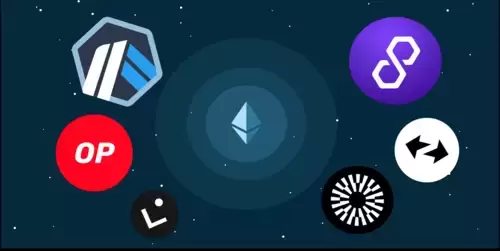 |
|
 |
|
 |
|
 |
|
 |
|
 |
|
 |
|
 |
|
 |
|
 |
|
 |
|
 |
|
 |
|
 |
|
 |
|
Cryptocurrency News Articles
Celo's Transition to an Ethereum L2 Blockchain Signals a Broader Industry Shift
Apr 01, 2025 at 07:17 am
Last week, something big happened in the crypto space, but only a few people fully understood its significance.

Last week, something huge happened in crypto, but few realized its full implications. Celo announced its transition from an independent L1 blockchain to an L2 blockchain on Ethereum.
This might seem like another tech migration, but it’s a sign of a broader shift that Ethereum has been silently driving, one that’s quickly changing how we view projects in crypto. Let’s break this down further.
1. Industry begins to take cost & revenue issues seriously
We are in the midst of a long overdue correction. Crypto markets are beginning to refocus on fundamentals. Narratives still matter, but now people are asking:
* What’s the actual revenue of this chain?
* How much does it cost to operate?
* Where does value accumulate?
A host of new metrics, like market cap to revenue (REV), are coming into play, revealing stark differences between seemingly similar blockchains.
This may be why Celo decided to switch to Ethereum L2.
2. L1 cannot generate revenue, but L2 can
This is often overlooked: L1 chains are not able to generate revenue in a sustainable way.
Why? Because all value goes directly to stakers or miners. L1 collects fees, which are immediately distributed as block rewards or staking returns. There is no retained profit margin, no surplus, and no funds are left to fund innovation or protocol development.
This creates a strange situation where L1s can be extremely valuable platforms but still operate like public infrastructure, with no built-in funding mechanisms to enable their development and evolution.
Contrast this with L2, which is able to retain and redeploy revenue. Collator fees, maximum extractable value (MEV), or even custom charges for block space can be retained and reinvested in R&D, developer funding, growth promotion activities, or public goods. This is a model that can achieve true sustainability and align incentives over time.
This is why so many new ecosystems choose to prioritize building L2. It’s not just about technical architecture, it’s also about economic design.
3. L1 is the mainframe in the Web3 era
Here’s a simple mental model: L1 blockchains are like mainframes for crypto.
In the early days of the Internet, if you wanted to run a serious application, you had to buy a mainframe. You had to maintain the hardware, write your own network stack, and be responsible for every aspect of the system’s uptime, security, performance, etc. It was powerful, but expensive.
Running an L1 blockchain today faces a similar situation. You need your own consensus mechanism, your own set of validators, and your own token incentives to secure the network. It costs you millions of dollars every year to keep the system running and secure.
Taking Celo as an example, they spend 4% to 6% of the total token issuance each year, about 15 to 25 million US dollars per year, just to maintain basic security and normal operation of the system.
This is not uncommon. It’s true for Ethereum and it’s true for Solana. Every independent L1 has to bear this cost. But the key is: this cost does not decrease with scale. If you are a smaller L1 chain, the cost you bear may be overwhelming.
4. L2 is like a hosted server: just as powerful, but cheaper
Now imagine that instead of running a mainframe, you switch to a managed server.
You still have control over your environment, you can customise how your blockchain runs, and you still have autonomy over execution, but you don’t have to secure the physical equipment yourself, which is what L2 on Ethereum does.
Celo, as L2, will still provide the same user experience. But now, the heavy lifting of security, such as fraud proofs, consensus mechanisms, and finality of the base layer, is handled by Ethereum. The cost of maintaining this chain has dropped significantly.
Instead of $20 million per year in security costs, the costs are now just state storage fees and data availability costs, which can be further reduced through data compression and the use of alternative data availability layers (Celo chose EigenDA).
5. Why this is a strategic masterstroke for Ethereum
This isn’t just about Celo; it also means that Ethereum’s long-term strategy is finally starting to fall into place.
Ethereum is no longer seeking to be the “one server to rule them all.” That vision of a single dominant chain has been proven wrong in every era of computing, whether it’s Web1, Web2, and now Web3.
Instead, Ethereum is becoming a base layer on which other chains can be built, providing security, decentralization, and interoperability as a service.
Yes, at first glance this looks like cannibalization. Ethereum is reducing the “premium” of its L1 chain. But in reality, it
Disclaimer:info@kdj.com
The information provided is not trading advice. kdj.com does not assume any responsibility for any investments made based on the information provided in this article. Cryptocurrencies are highly volatile and it is highly recommended that you invest with caution after thorough research!
If you believe that the content used on this website infringes your copyright, please contact us immediately (info@kdj.com) and we will delete it promptly.
-

-

-

- ING is reportedly preparing to enter the Euro stablecoin market.
- Apr 23, 2025 at 01:40 am
- Dutch banking giant ING is reportedly preparing to enter the Euro stablecoin market. According to a report by CoinDesk on Tuesday, April 22, ING is setting up a consortium with several other banks to develop and launch a Euro-based stablecoin.
-

-

-

- RLUSD Debuts on Aave V3's Ethereum Core Market, Opening New Avenues for Ripple's DeFi Ambitions
- Apr 23, 2025 at 01:35 am
- Ripple has taken a significant step forward in its mission to become a key player in decentralized finance. Its dollar-pegged stablecoin RLUSD has been officially integrated into Aave V3's Ethereum Core Market, one of the most influential DeFi lending platforms.
-

- The changing cryptocurrency landscape in the United States could have a downstream impact on how businesses move, hold, store and monetize payments.
- Apr 23, 2025 at 01:30 am
- Paul S. Atkins was sworn into office as the 34th chairman of the Securities and Exchange Commission (SEC) Monday (April 21) after being confirmed by the Senate earlier this month.
-

-






























































